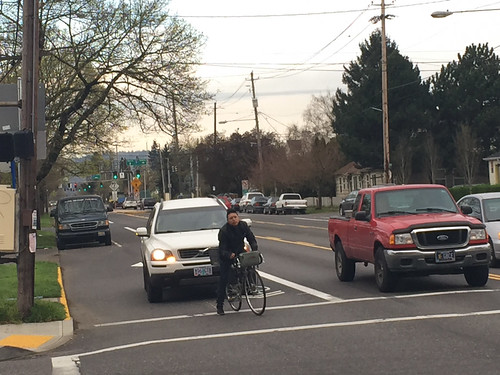The City of Portland Bureau of Transportation is trying out a new bike lane treatment on North Rosa Parks Way that they hope will lessen the risks of right-hook collisions.
A few weeks ago I noticed the bike lane on Rosa Parks (which was just installed in 2011) as it approaches Albina had been ground off about 50-feet from the intersection. In what used to be a parking lane and bicycle-only lane, PBOT has placed sharrow markings and a right-turn arrow.
The approach to this intersection used to offer dedicated, legally-binding right-of-way for bicycle users. Now it’s a shared environment where right-turning auto users and bicycle users (either going straight or turning right) mix together.
This isn’t the only place in town where PBOT has installed a “mixing zone” (NW Everett and NE Multnomah have them), but this is the first instance I’m aware of where an existing bike lane was removed and replaced with this treatment.
Advertisement
This is a major change to how PBOT treats bike lanes at intersections, so I called around to find out what spurred the new design and whether or not this is something we might be seeing more of.
Turns out this change started via a citizen complaint made to the 823-SAFE hotline. The complaint was fielded by PBOT Traffic Engineer Carl Snyder. In a phone interview, Snyder shared that he ran the complaint by one of PBOT’s bike experts, long-time employee Jeff Smith, and the two of them came up with this design solution.
“Part of me really feels that this is just codifying illegal right turns and puts people on bikes in greater danger.”
— Noah Brimhall, nearby resident
According to Snyder the problem at this intersection was with auto users who would illegally drive over the bike lane prior to the intersection and use the bike lane and/or parking lane to make their right turn. (Oregon law requires that when a bicycle lane is present, drivers must stay out of the bike lane until the intersection.)
This is a scenario that Snyder acknowledges PBOT has “struggled with” for many years (and that’s definitely true). Some people prefer the California example of encouraging auto users to pull into the bike lane prior to the intersection to make a turn, thus reducing the risk of right hooks.
“It’s not a perfect design,” Snyder told us, “but we’ve tried this in some other places and the results are mixed.”
It comes down to where to you want drivers to cross your path; somewhere prior to the intersection or at a known spot in the intersection. Another consideration is that if someone is in a standard lane waiting for a bicycle lane to clear, they are holding up other drivers who want to go straight.
Snyder described scenarios at this intersection of people simultaneously turning right from both lanes (the thru lane and the parking/bike lane). “It’s a problem not just for bikes but for cars too,” he said.
I’m surprised to see PBOT doing this type of design because in the past they have defended the Oregon style bike lane. The thinking is that drivers need to respect the bike lane at all times and by creating some locations where people can drive in them sends a mixed message.
A benefit of this new shared design, Snyder says, is that it’s more clear where the conflict point exists.
There’s no relevant history of collisions at this intersection and it has relatively low vehicle volumes.
Noah Brimhall lives nearby and is the former transportation chair of the Piedmont Neighborhood Association. He says he has, “really mixed feelings about these changes.”
Here’s more from Brimhall:
“I know that before the change folks driving cars regularly turned right from Rosa Parks on to Albina from the bike lane and I found this really annoying and dangerous. One could make the argument that this is a way to make folks driving cars aware of the presence of people on bikes and make sure they know to share this space, but part of me really feels that this is just codifying illegal right turns and puts people on bikes in greater danger. It also feels like a further dilution of the sharrow and it seems like transport agencies are just using the sharrow in every possible situation where a bike could be on a road, but they don’t feel like (or can’t) actually put in a dedicated facility for people on bikes.”
Snyder acknowledged that prior to the change, people in cars were “not doing what they were supposed to do” and it’s his hope that the new design better clarifies those movements.
He added that this is not going to become a new standard treatment but that they’ll monitor how it works. How does Snyder think the design will work? “I think the jury’s out.”
Have you ridden this new mixing zone on Rosa Parks (or elsewhere)? What do you think?





